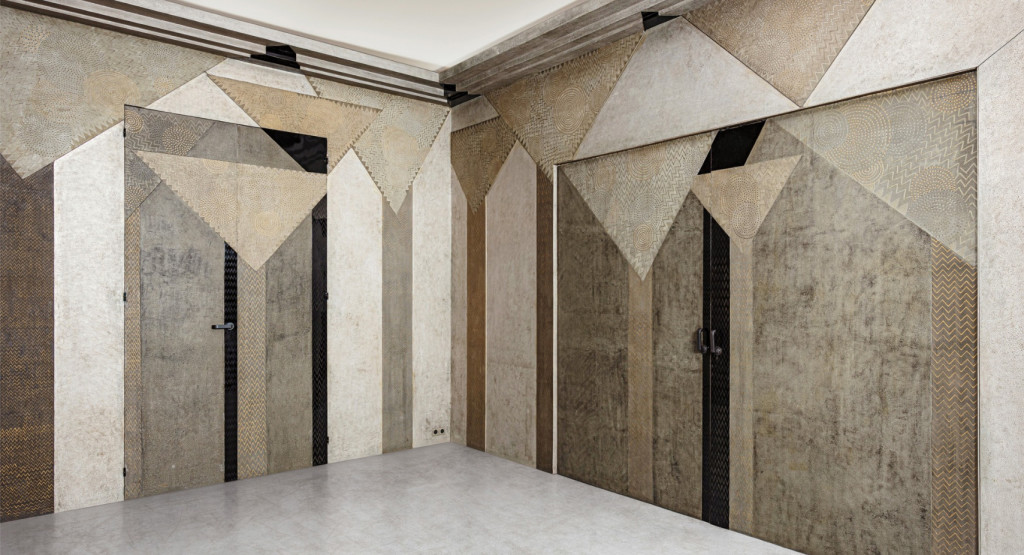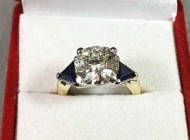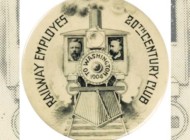LONDON — An Art Deco “Les Palmiers” lacquered wood, lacquered metal and gilded wood smoking room, designed by Jean Dunand (1877-1942) and installed between 1930 and 1936 in the Parisian apartment of Mademoiselle Colette Aboucaya, led Phillips’ June 30 Design sale.
The 170-lot sale achieved $16,242,129 and was 88 percent sold by lot; the total was reported to be the highest total for a Design sale in company history.
Bidding on the lot opened at one million pounds and inched upward, coming down to a five-minute battle between two phone bidders, one with global chairwoman, Cheyenne Westphal, the other with Domenico Raimondo, senior director, head of the Design department in Europe and senior international specialist. Raimondo was the first to split bidding increments and eventually won the lot, for $4,550,036, more than twice its low estimate. It was, apparently, a world record auction price for a work by Dunand.
After the sale, Raimondo said, “We were immensely proud to have been entrusted with the sale of Jean Dunand’s unrivalled masterpiece ‘Les Palmiers’ and are grateful to our clients who recognized its importance and committed themselves to it, which ultimately led to a world record result for this master of French Art Deco.”
Published in no fewer than six books and periodicals, the room had traded hands a few times, most recently when it was acquired by the present seller, identified as an important European private collector, who paid $3,097,832 for it when Christie’s sold it on March 30, 2011.
In 1925, on the occasion of the International Exhibition of Modern Decorative and Industrial Arts held in Paris, for the first time Jean Dunand created lacquered wall-panels that delineated an entire room. Having taken lessons with the Japanese lacquer master Seizô Sugawara, Dunand realized numerous works in which this new material took precedence over the significance of copper and metal in his repertoire. In 1921, Dunand also began to create furniture incorporating lacquer and eggshell inlays.
The room was one of a few executed by Dunand.
Following his new experiments in lacquer and having established a great reputation, Dunand was entrusted by Maurice Bokanowski, the president of the Société des Artistes Décorateurs, to design a ‘smoking room’ for the private apartments of the French Embassy pavilion for the 1925 International Exhibition. Measuring nearly 10 feet high, the walls were covered with black lacquered panels surmounted by a backlit silver lacquered ceiling, creating a cozy atmosphere.
A few years later, the American patron Charles Templeton Crocker called upon Dunand to create three rooms for his residence in San Francisco: the breakfast room, covered with a motif of Japanese fish on a black lacquered background; the bedroom, decorated with does on a background of stylized vegetation; and the dining room, decorated with gold radiant lacquer.
In 1928, the Aboucaya family, originally from Algeria, acquired coachbuilder Henri Binder’s company, with which Dunand had collaborated. The coachbuilder continued his partnership with Dunand, during which time the young Colette Aboucaya commissioned the designer to create the boiseries of the smoking room for her apartment in rue de Monceau. In accordance with Mademoiselle Aboucaya’s decorator Gérard Mille, Dunand designed a forest of stylised palm trees in tones of silver, gold and black lacquer with integrated lacquer metal plates, which added texture to the surface and extended the “palm grove” to the cornices of the ceiling.
The room was completed alongside his design for the Normandie ocean liner, which required much of Dunand and his workshop’s time and energy. Therefore, the smoking room for Colette Aboucaya was not finished until 1936. Following his father’s death, Bernard Dunand completed the decoration of the apartment, including an additional bedroom.
For additional information, www.phillips.com.





